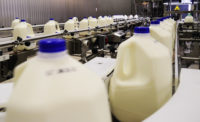A shelf-life study is used to evaluate the time, under specified storage conditions, that a food will tolerate without producing unacceptable microbiological, chemical, physical and/or sensory changes. Even though there are a lot of shelf-life prediction models available in the food industry, as well as some estimation tests such as the preliminary incubation test or the Moseley Keeping Quality test, an experimental real-time study is the best way to collect actual analysis data and better estimate the shelf life of a product such as fluid milk.
Usually, a fluid milk product will have both a primary shelf life and a secondary shelf life. The primary shelf life is the longest storage time of the unopened product at which the product is still acceptable for consumers’ consumption. The secondary shelf life, also referred to as the open shelf life, is the longest acceptable time a product should stay opened before it is consumed. It is recommended that food companies evaluate both the primary shelf life and the secondary shelf life of a product to provide better instructions for the consumer.
Microbial analysis
The shelf life of fluid milk can vary based on raw milk quality, the pasteurization process, the packaging process and post-contamination as a result of consumer practices. The shelf life can range anywhere from a few weeks to several months.
With these considerations, microbial spoilage is the primary quality concern in fluid milk products; it can compromise milk quality quickly by producing acids and gas. Using the methods referenced in the Standard Methods for the Examination of Fluid Milk, a microbiological analysis of standard plate count and a coliform count are recommended.
Sensory evaluation
Sensory is also an attribute used to determine the shelf life of a fluid milk product. Appearance, odor, flavor and mouthfeel should be evaluated to capture sensory change and help with determining the shelf life. Different sensory evaluation methodologies can be applied based on different purposes; they can include consumer panel evaluations, discrimination sensory evaluations or descriptive sensory evaluations.
A trained sensory scientist can evaluate sensory attributes that are particular to fluid milk. These attributes may include being cooked, unclean, highly acidic or oxidized. For example, acid flavor is defined as sour/tart and might cause a tingling sensation on the tongue. “Cultured milk” or “sour” odors might be present in acid-flavored milk. This flavor manifestation is due to the growth of lactic acid-producing organisms.
Chemical analysis
Chemical analysis to evaluating rancidity (i.e., thiobarbituric acid reactive substances) can also be evaluated in milk products with fat content. A correlation between analytical tests and sensory evaluation can be applied to develop a specification for the milk product.
Some milk products might be fortified with nutrients such as vitamin D; the nutrients should also be evaluated for the nutritional-label claim. Nutrients such as vitamins can degrade quickly over the shelf life due to various environmental stresses. The level of fortified nutrients should meet 100% of the claim at the end of shelf life, as required by FDA regulations.
When conducting a shelf-life study, freshly manufactured milk products should be used and stored at specified controlled storage conditions, typically 7 degrees Celsius. It is recommended that the product be tested for intended shelf life plus 25% to 50%, with five to seven time points over the duration of the shelf life — and with two production lots and three samples per lot at each time point, based on National Advisory Committee on Microbiological Criteria for Foods guidelines.









